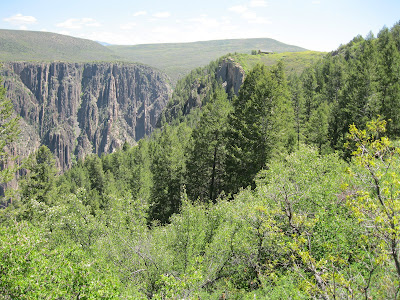The Black Canyon of the Gunnison National Park in southwest Colorado has nine short trails to overlook points between the south rim Visitor Center and Warner Point at the end of the Rim Rock Drive. Seven of the short overlook trails have the one way distance in yards posted.
Adding up all the distances, I got about 4000 total yards, or about 2.3 miles of walking to see all the overlooks. Some of the interpretive signs in the Visitor Center are repeated along the trails, explaining the overwhelming scenery.
At the Pulpit Rock Overlook there is discussion of how the Black Canyon is shaped. The north rim is much steeper than the north facing south rim.
The next three overlooks are nearly side by side. Cross Fissures, Rock Point, and Devils Overlook are relatively long with Devils Overlook the longest at 607 yards.
In this area you can see some of the Pegmatite Dikes. Molten Pegmatite rocks have squeezed into the cracks to form lighter colored bands. The lighter bands of rock contain the common minerals of Mica, Feldspar, Quartz, and Garnet.
The Narrows, between Pulpit Rock and Chasm View is the shallowest and narrowest section of the Canyon. This area was very difficult for early surveyors to pass. Interpretive information says that the canyon width at Chasm View is 1100 feet and 1820 feet deep. The Gunnison River has a very steep gradient, averaging 95 feet per mile, giving the river the energy to cut downwards.
The Painted Wall is probably the most dramatic of the view points. This is the highest cliff in Colorado at 2300 feet. The patterns here were created more than one billion years ago as molten rock squeezed into existing rock. These cliff overlooks are good places to see the White-throated Swifts and the Violet-green Swallows.
The Cedar Point View Point has more views of the Painted Wall and also has small signs identifying many of the common plants. This area has more Pinyon Pine and Juniper trees than the area closer to the Visitor Center.
Dragon Point also has views of the Painted Wall and a good view down the Black Canyon.
Sunset View doesn't have a trail long enough to be concerned about the distance. On a clear day Monument Mesa and Grand Mesa are visible in the distance. The last viewpoint is at High Point where the 1.4 mile Warner Point Trail is located. It took me 2:30 hours to visit all these view points.
Advice from the Black Canyon: Carve out a place for yourself. Aspire to new plateaus. Stand the test of time. Don’t get boxed in. Listen to the voice of the wind. It’s OK to be a little off the wall. Reach Deep!










































